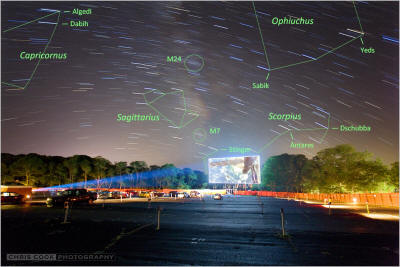by neufer » Fri Sep 20, 2013 2:30 pm
Joe Stieber wrote:I was curious about the specific stars and constellations in this picture, so I labeled a copy of it:
 Click here
Click here for a larger version.
Might also mention:
- 1) The far left car with its headlights on to illuminate the other cars
2) The 'backwards' car to block "chrome glare" caused by the first car.
------------------------------------------------------------------------------
I had never thought much about
M24 &
M7 before.
http://en.wikipedia.org/wiki/Messier_24 wrote:
<<
The Sagittarius Star Cloud (also known as Delle Caustiche, Messier 24, IC 4715) is a star cluster in the constellation of Sagittarius, approximately 600 light years wide, which was discovered by Charles Messier in 1764. It is sometimes known as the Small Sagittarius Star Cloud to distinguish it from the Great Sagittarius Star Cloud located to the north of Gamma Sagittarii and Delta Sagittarii. The stars, clusters and other objects comprising M24 are part of the Sagittarius or Sagittarius-Carina arms of the Milky Way galaxy. Messier described M24 as a "large nebulosity containing many stars" and gave its dimensions as being some 1.5° across. M24 fills a space of significant volume to a depth of 10,000 to 16,000 light-years. This is the most dense concentration of individual stars visible using binoculars, with around 1,000 stars visible within a single field of view.>>
http://en.wikipedia.org/wiki/Messier_7 wrote:
<<
Messier 7 or M7, also designated NGC 6475 and sometimes known as the Ptolemy Cluster, is an open cluster of stars in the constellation of Scorpius. The cluster is easily detectable with the naked eye, close to the "stinger" of Scorpius. With a declination of -34.8°, it is the southernmost Messier object. M7 has been known since antiquity; it was first recorded by the 1st-century Greek-Roman astronomer Ptolemy, who described it as a nebula in 130 AD. Italian astronomer Giovanni Batista Hodierna observed it before 1654 and counted 30 stars in it. In 1764, French astronomer Charles Messier catalogued the cluster as the seventh member in his list of comet-like objects. English astronomer John Herschel described it as "coarsely scattered clusters of stars". Telescopic observations of the cluster reveal about 80 stars within a field of view of 1.3° across. At the cluster's estimated distance of 980 light years this corresponds to an actual diameter of 25 light years. The tidal radius of the cluster is 40.1 ly and it has a combined mass of about 735 times the mass of the Sun. The age of the cluster is around 200 million years while the brightest member star is of magnitude 5.6. In terms of composition, the cluster contains a similar abundance of elements other than hydrogen and helium as the Sun.>>
[quote="Joe Stieber"]I was curious about the specific stars and constellations in this picture, so I labeled a copy of it:
[img]http://wasociety.us/APOD/drive-in-night-Cook-labeled-400.jpg[/img]
[url=http://wasociety.us/APOD_Sept-20-2013.htm]Click here[/url] for a larger version.[/quote]
Might also mention:
[list]1) The far left car with its headlights on to illuminate the other cars
2) The 'backwards' car to block "chrome glare" caused by the first car.[/list]------------------------------------------------------------------------------
I had never thought much about [url=http://apod.nasa.gov/apod/ap130712.html]M24[/url] & [url=http://apod.nasa.gov/apod/ap120912.html]M7[/url] before.
[quote=" http://en.wikipedia.org/wiki/Messier_24"]
<<[url=http://apod.nasa.gov/apod/ap130712.html]The Sagittarius Star Cloud[/url] (also known as Delle Caustiche, Messier 24, IC 4715) is a star cluster in the constellation of Sagittarius, approximately 600 light years wide, which was discovered by Charles Messier in 1764. It is sometimes known as the Small Sagittarius Star Cloud to distinguish it from the Great Sagittarius Star Cloud located to the north of Gamma Sagittarii and Delta Sagittarii. The stars, clusters and other objects comprising M24 are part of the Sagittarius or Sagittarius-Carina arms of the Milky Way galaxy. Messier described M24 as a "large nebulosity containing many stars" and gave its dimensions as being some 1.5° across. M24 fills a space of significant volume to a depth of 10,000 to 16,000 light-years. This is the most dense concentration of individual stars visible using binoculars, with around 1,000 stars visible within a single field of view.>>[/quote][quote=" http://en.wikipedia.org/wiki/Messier_7"]
<<[url=http://apod.nasa.gov/apod/ap120912.html]Messier 7 or M7[/url], also designated NGC 6475 and sometimes known as the Ptolemy Cluster, is an open cluster of stars in the constellation of Scorpius. The cluster is easily detectable with the naked eye, close to the "stinger" of Scorpius. With a declination of -34.8°, it is the southernmost Messier object. M7 has been known since antiquity; it was first recorded by the 1st-century Greek-Roman astronomer Ptolemy, who described it as a nebula in 130 AD. Italian astronomer Giovanni Batista Hodierna observed it before 1654 and counted 30 stars in it. In 1764, French astronomer Charles Messier catalogued the cluster as the seventh member in his list of comet-like objects. English astronomer John Herschel described it as "coarsely scattered clusters of stars". Telescopic observations of the cluster reveal about 80 stars within a field of view of 1.3° across. At the cluster's estimated distance of 980 light years this corresponds to an actual diameter of 25 light years. The tidal radius of the cluster is 40.1 ly and it has a combined mass of about 735 times the mass of the Sun. The age of the cluster is around 200 million years while the brightest member star is of magnitude 5.6. In terms of composition, the cluster contains a similar abundance of elements other than hydrogen and helium as the Sun.>>[/quote]